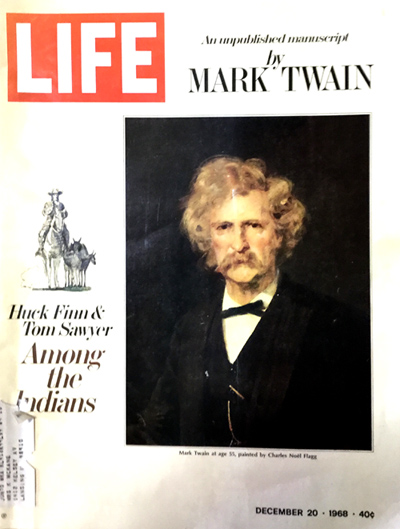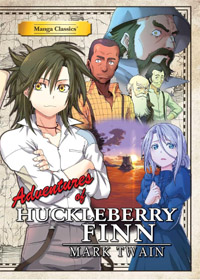Quotations
| Newspaper
Articles | Special
Features | Links
| Search
SPECIAL
FEATURE
by Don Pellegrino (Pittsburgh)
© January 2025
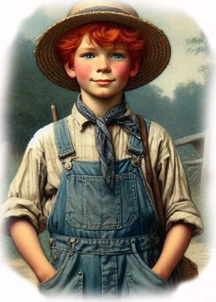 |
Tom, Huck and Companions
|
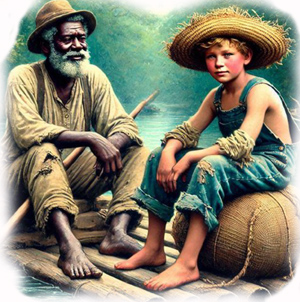 |
|
Although Mark Twain died 115 years ago, the characters he created in his Tom and Huck novels continue to have new adventures in the 21st Century. His creations from these novels have appeared in at least 32 new books by various authors since the turn of the millennium. All of these new books have kept the characters alive and updated, and not left them on a library shelf as simply "A Classic--a book which people praise but don't read"--as Mark Twain wrote for "Pudd'nhead Wilson's New Calendar." Tom & Huck by Mark TwainDuring the 19th century, Mark Twain published four books that included the characters Tom Sawyer and Huckleberry Finn: The Adventures of Tom Sawyer (1876) The first two are among the most famous, well-known novels in American literature. Almost everyone is aware of the fence painting episode in The Adventures of Tom Sawyer. Adventures of Huckleberry Finn is acknowledged as one of the greatest American novels and still draws lots of attention both good and bad. Both are still widely-read and talked about. The other two are shorter novelettes, that often get overlooked. Mark Twain also composed several other Tom and Huck stories, and wrote a Tom Sawyer play which were among his unpublished works when he died. These writings first saw the light of publication in the 20th Century. In 1969, The Mark Twain Papers and the University of California Press published Hannibal, Huck & Tom edited with an introduction by Walter Blair. This book covered Twain's writings on Hannibal (which is the basis for St. Petersburg in the Tom and Huck novels) and the start of several new Tom and Huck novels and the complete but never produced Tom Sawyer: A Play. It should be noted, especially as we look at how other writers change or interpret Mark Twain's characters in the 21st Century, that the play completely alters the romantic relationship between Tom Sawyer and Becky Thatcher that readers are left with after reading the novel. Mark Twain was the first one to change our perceptions of his characters. One of the stories from Hannibal, Huck & Tom was "Huck Finn & Tom Sawyer Among the Indians." It was used as the cover story in Life magazine's December 20,1968 edition. Life was one of the leading mass read periodicals of that time with a cover price of 40 cents. This story will be discussed several times in this article. |
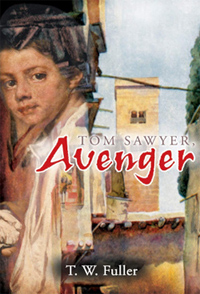 available from Amazon |
1. Tom Sawyer Avenger by T. W. Fuller, Writers Club Press, an imprint of iUniverse Press, Lincoln, Ne., 2000. Biographical information on T. W. Fuller is lacking and his true identity is open to question.. Stylistically, this is a difficult book to read. Pap Finn has a first name, Jimmy. And while many of the characters are very familiar, the incidents and resolutions change. Huck and Jim are on Jackson Island, presumed dead and stay there during this story. As a result, most of the adventures are of Tom and Becky together, and many new characters are introduced. When Judge Thatcher awards the recovered treasure to the Widow Douglas, as guardian of Huckleberry Finn, it is on page 3, not at the end as in the original Adventures of Tom Sawyer book. Jimmy Finn, since he is Huck's dad, is furious at the Judge. He takes his revenge by kidnapping the judge's daughter Becky. Tom helps her escape, and more excitement occurs. Even though Tom wants to have his "revenge" on Jimmy, he learns he is dead before he can. At the end, recalling their time playing pirates, Becky calls Tom her "fearless Black Adventurer," and herself "Joan of Arc" (a reference to Twain's book Personal Recollections of Joan of Arc,1896). |
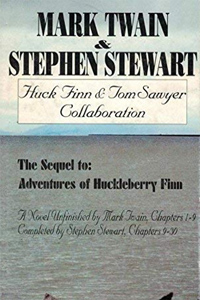 available from Amazon |
2. Huck Finn & Tom Sawyer Collaboration by Mark Twain and Stephen Stewart, New Mill Publishing, Meadow Vista, Ca., 2001. Stephen Stewart is an author of sixteen books across different genres. On his front inside cover, he describes himself as a student of Twain, having intensely studied him for over seventeen years before writing this book. Stewart is the first of two different authors who attempted to finish Mark Twain's story "Huck Finn & Tom Sawyer Among the Indians." Twain's part covers 72 of the 289 pages of this collaboration. Stewart's part starts in the middle of Chapter Nine. There is an excellent review by Craig Milliman of Huck Finn & Tom Sawyer Collaboration on the Mark Twain Forum. Milliman states that "Stewart should be admired for his courage in tackling this project, if not for his literary skills." Stewart gives his version of what happens to Peggy and her sister Flaxy. Tom and Huck have new adventures, meeting others along a journey West, including mountain men, a black settler, and lots of Indians. Tom and Huck are even at Little Big Horn. While Milliman likes the descriptions of the plains that they travel through, he is critical of how Twain's characters evolve in the book, especially Stewart's treatment of Jim, and Huck's loss of innocence. As Milliman explains "the loss of Huck's innocence is the real fate worse than death in this sequel" in both Huck's description of gang rape and how he "cheerfully plans a trip to a brothel with Tom and Jim." Nevertheless, Milliman states that this story "has moments of excitement, humor and truth." |
 available from Amazon |
3. Huck Finn & Tom Sawyer Among the Indians
by Mark Twain & Lee Nelson, Council Press, Springville,
Utah, 2003. As an aside, Huck Finn & Tom Sawyer Among the Indians is not the only unfinished piece of Mark Twain's work that another author has completed. In 2017 Phillip Stead with illustrations by his wife Erin Stead finished Mark Twain's 1879 non-Tom/Huck story written for his children, The Purloining of Prince Oleomargarine. This book is based on an unfinished story Mark Twain outlined in rough notes of sixteen pages which is among his writings at The Mark Twain Papers, University of California, Berkeley, Ca. (8). |
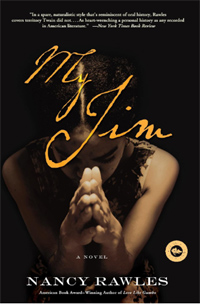 Available from Amazon |
4. My Jim by Nancy Rawles, Crown Publishing Group, division of Random House, New York, 2005. According to her Wikipedia web page, Nancy Rawles has a degree in journalism from Northwestern, is a playwright, and has written three books. The year is 1884. Jim's granddaughter, Marianne Libre is sixteen years old, and has received a marriage proposal from a soldier in the Ninth Cavalry after he received orders to move west. She discusses these life-changing events with her grandmother, Sadie Watson, with whom she lives. Sadie's husband, Jim and her two children are now dead, and Marianne's dilemma triggers Sadie to think about and relate her life with her deceased family. This book received very good reviews when it was published. A quote from a People magazine reviewer appears on the opening page-- "There is much about Mark Twain's young slave that you may remember but haven't really felt until now." |
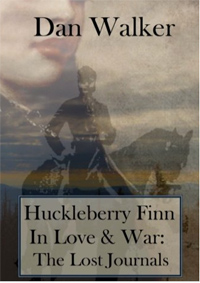 Available from Amazon |
5. Huckleberry Finn In Love & War: The Lost Journals by Dan Walker, self-published, 2007; (second edition 2014). The back cover of Dan Walker's book states he has been an historian at a National Military Park and is a college level teacher who has taught English, creative writing and teacher education. In a book review by David Davis on the Mark Twain Forum, he states that Huckleberry Finn "should never grow old." But in this book, Huck, Tom, Sid, and Becky do grow old. There is, as Davis points out, little mention of Jim. The story picks up where Twain left off in Adventures of Huckleberry Finn. Huck does light out for the territory and begins keeping journals which are later read by others who had interaction with him. The book intersperses quotes from these journals into a narrative story. The story tells what happens to Twain characters during the trials and horror of the Mexican American War (1847), Civil War and Western expansion. These major events greatly impact their lives. Huck has a romance with Mariposa, a young woman from a noble Mexican Family. He also has an unsuccessful short period at West Point. The characters encounter Robert E Lee and Stonewall Jackson. Davis states that this book is a "good read that gets you thinking" and that "the level of detail for the battlegrounds and other sites is impressive.". |
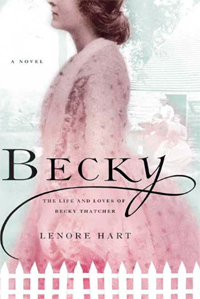 Available from Amazon |
6. Becky: The Life and Loves of Becky Thatcher by Lenore Hart, St. Martin's Press, New York, 2007. Lenore Hart describes herself on her web page as "a novelist, poet, writing professor and editor." She has received numerous awards and has been featured on the PBS-TV series "Writer to Writer." Besides the regular Tom and Huck characters, Sam Clemens is in the book. In the Introduction we find out that now, in 1910 (incidentally the year Mark Twain died at 75), that Becky is 72 years old, living in San Fransico. She has outlived her parents, two husbands and a child. She states in her opening pages that Sammy, as she first knew him, will always be to her "the redhead child who never got a story straight; the one who always had to improve truth." Becky travels in the book from Missouri, through Nevada to California which are all places Mark Twain went in his life. Becky sets the record straight on herself, Tom, Huck, Sis, Jim, and many others both recalling episodes from The Adventures of Tom Sawyer, and portions from her own life that are new to the reader. Becky is a strong, stubborn person, who is a wife, a mother and by the end a newspaper reporter, a profession that a young Sam Clemens also had held. R. Kent Rasmussen's review in the Mark Twain Forum states that this "is a well-written book but one that demands a close reading to appreciate its nuances as it shifts around in time." He does not like revisions to the character of Tom Sawyer and states that the "novel even negates the premise on which Huckleberry Finn is based." |
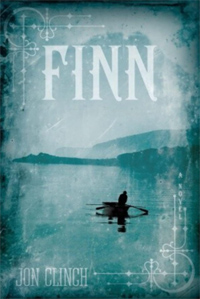 Available from Amazon |
7. Finn by Jon Clinch, Random House, Inc., New York, 2007. According to Jon Clinch's website, Finn was his debut novel. He has written several other novels since then, including Marley which is based on Charles Dicken's A Christmas Carol and The General and Julia, based on the life of Ulysses S. Grant. Finn won several awards when it came out, including designation as one of the best novels of the year by the Washington Post, the Chicago Tribune, the Christian Science Monitor, and Book Sense. Although the book is about Huckleberry's father, there is no narrator; rather it is in the story telling style of The Adventures of Tom Sawyer. This is Pap Finn's story. The book contains several characters from Twain's work besides Pap and Huck, including Judge Thatcher and the Widow Dougles. Clinch introduces a number of new characters, including Pap Finn's father, his sycophantic brother Will, a blind moonshiner Bliss, and Mary, who is a stolen slave who becomes Pap Finn's mistress. Pap Finn has all the characteristics of Twain's original -- drunkenness, cruelty, and overwhelming hatred of blacks. In his Author's Note at the end of his book, Clinch states his book follows these themes to an end. We get the backstory of Pap. Clinch assumes that Huck in Twain's book was not a reliable narrator, and thus provided the author some latitude. Chapter Nine of Adventures of Huckleberry Finn, where Pap is found dead by Jim, is retold in this book, as are a few other scenes. Most descriptions and reviews of Finn include the word "dark." And much of it is. R. Kent Rasmussen's very detailed review in The Mark Twain Forum found it a "disturbing novel" especially "its raw language and its disturbing exploration of sensitive racial issues." Rasmussen thought some readers may feel Clinch committed a "crime, using characters and episodes from Mark Twain's Huckleberry Finn." Rasmussen asks, "instead of objecting to what Clinch has done to Huck, perhaps we should ask ourselves why the idea of his being part black bothers us?" |
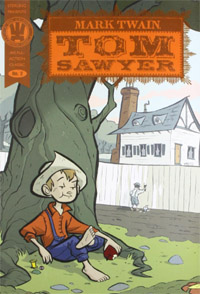 Available from Amazon |
8. Tom Sawyer. Adapted by Tim Mucci (Author) and Rad Sechrist (Artist), Sterling Publishing Co., New York, 2008. According to Tim Mucci's website he is a writer of graphic novels, comics and other media. Rad Sechrist's website reveals he is a storyboard character designer working in animation. He has worked with Disney, Cartoon Network, Random House and Barnes and Nobles. This book is a graphic novel, a narrative work in which the story is conveyed to the reader using sequential art. So why include this book in this study? A July 1, 2022 article in Publishers Weekly revealed sales of graphic novels in the USA and Canada had increased over the last twenty years, from $805 million in 2012 to $1.87 billion in 2023. Many book sellers, including Barnes and Noble, have a growing selection in their stores. There have been numerous comic books over the years using Twain's novels. A Goodreads reviewer described this book, "With its lively, fun narrative and irrepressible hero, Tom Sawyer is tailor-made for the graphic novel format." This book introduces young readers to Twain's work. It generally follows the original story using pictures and words to communicate. Additionally, at the end of the book there are 12 pages about Mark Twain and his books. |
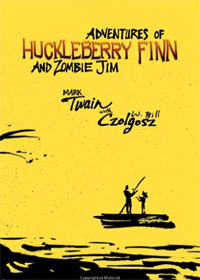 Available from Amazon |
9. Adventures of Huckleberry Finn and Zombie Jim
by Mark Twain and W. Bill Czolgosz, Gallery Books, a division
of Simon & Schuster, New York, 2009. According to his Goodreads
profile , W. Bill Czolgosz is a Canadian author of nine
books. While the upfront Notice in the book is the same as in Twain's book, the Explanatory, adds additional dialects-- "the grizzled grumblings of the not dead, the nearly dead, and the certainly dead, and four modified varieties of the last." In Chapter One before Huck begins narrating his story, he explains that "the only thing that stuck with me that I ever was taught" was Miss Watson not allowing me to ever use "that word" used to refer to "the people who used to be owned by other people" (p. 5). The back cover describes the story line as a "pox is killing men, bringing them back meaner and hungrier than ever and zombies all over are giving in to their urge to eat." This does add an extra dimension to traveling by raft down the Mississippi. |
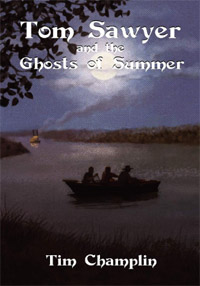 Available in Kindle edition |
10. Tom Sawyer and the Ghosts of Summer by Tim Champlin, Pill Hill Press, Chadron, Nebraska, 2010. Tim Champlin, who died in October 2024, published 65 novels according to his Goodreads page. His works are mostly Westerns and historical fiction. He considered Mark Twain one of five favorite authors. He was part of an author's club, the Western Writers of America. In an interview with Brandy Wyatt of the Dalton (Ga) Daily Citizen in June 2020, he stated his friend Mark Twain scholar Kent Rasmussen, "has given me good advice and helped me in many ways." This is the first of four Tom and Huck books by Champlin (see #20, #21 and #26 below) that are aimed at young readers (ages 8 to12). Champlin used Mark Twain as a character in an earlier book, Fire Bell in The Night (2004). This book has two parts. The first part occurs in the summer of 1950 where Matt Lively, a 12-year-old, is enjoying life, playing with his friends, and hoping summer will never end, so he will not have to enter high school. At the end of this section, he catches typhoid fever. In part two he finds himself and one of his friends in 1848 Hannibal. He meets Tom, Huck and many of their companions, and they have many adventures reminiscent of the original Tom book. Kevin Mc Donnell in his review for the Mark Twain Forum describes the ending where Matt meets a new friend on a steamboat, Sammy Clemens, who soon drowns. Matt tries performing CPR, and "as life ebbs from Sammy's body, Tom and Huck slowly dematerialize and fade from view. Does Matt save his new friend, and do Tom and Huck come back to life? I reckon this reviewer ain't no spoiler." |
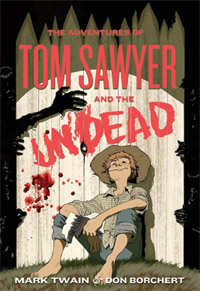 Available from Amazon |
11. The Adventures of Tom Sawyer and the Undead by Mark Twain and Don Borchert, A Tom Doherty Associates Book, New York, 2010. Don Borchert is an assistant librarian in a suburb of Los Angles, and an author of three books. In the Introduction of this book, he is still a librarian, but he supplements his work as a reporter working with Mark Twain on the Hannibal Post-Courier (p. 9). The time of this book is the 1870's. According to the Goodreads review of Borchert's book, the "world has been overrun by a zombie virus that turns people into something folks call "Zum." Tom, Huck and their friends, rather than playing pirates and other games in Twain's original, now play games of killing Zum, but eventually the games turn into reality. They will need to save their town! And rather than painting Aunt Polly's fence, they sharpen fence posts to make weapons. Tom becomes a "grade-A zombie hunter." This is just a fun modern take on Tom and Huck. |
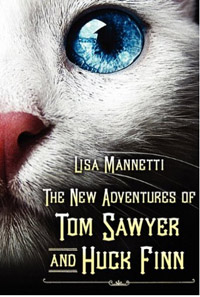 Available from Amazon in Young Adult Edition |
12. The New Adventures of Tom Sawyer and Huck Finn by Lisa Mannetti, Smart Rino Publications, 2011. Young Adult Version, 2014. According to her Goodreads biography, Lisa Mannetti is an author of 27 books (including horror, fiction and non-fiction, and thrillers), novelettes, short stories and articles in newspapers and magazines. She lives in a 100-year-old house with two cats. This last point is important to this book. (Mark Twain also liked and had many cats throughout his life.) Tom is the narrator of this book. In his Explanatory that "me and Huck comin back as twin brothers and the feline familiars of a twenty-first century witch--and you got even more trouble" (p. 3). Tom and Huck are now adopted white fur and bright blue-eyed cats. Their names are Cream Puff and Coconut, but Tom is not sure which is which. And thus, their adventures begin. They soon move to a new house, there is a witch, there are holidays like Halloween, Christmas and Valentine's Day, and there are house guests--a fun time if you can relax and accept the premise. Mark Twain is referenced on p. 65 for telling stories. Reviewer Meli Hooker wrote that Mannetti "weaves a beautiful, heartwarming and humorous fantasy with delectable Tom and Huck, but resurrects them with the love and care only a true fan and scholar of Twain could." (p. 1). |
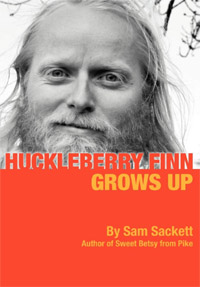 Available from Amazon |
13. Huckleberry Finn Grows Up by Sam Sackett, iUniverse, Inc., Bloomington, In, 2012. Sam Sacket wrote thirteen novels and many articles before his death in 2018. After being burnt out from being a professor of English for 23 years, in Kansas, he moved to Oklahoma, Thailand and back to the USA. Besides borrowing Twain's characters, he also wrote The Robin Hood Chronicles and Adolf Hitler in Oz. Both Wikipedia and Goodreads feature insightful thumbnail biographies of Sackett. Mark Twain was one of Sackett's favorite authors, and in the dedication at the front of this book he thanks teachers who developed his appreciation of the author. This book continues Huck's story from the end of Mark Twain's Adventures of Huckleberry Finn. Sackett, in the introductory note to the book, explains that he is the editor and Huck the author. The book begins in 2004. A lock box was opened in at a college in Kansas that contained 27 notebooks in Pitman shorthand. Four stenographers were found to translate these dictations which cover Huck's leaving Missouri in about 1842 until 1865, when Huck is in his thirties, married and living in Lawrence Kansas. The editor does not know why the notebooks end there. From theSackett's back cover, "In this tale, Huckleberry Finn embarks on a journey of self-discovery where he eventually uncovers the truths about "sivilization," slavery, and the difference about right and wrong." |
 Available from Amazon |
14. The Boy in His Winter, An American Novel by Norman Lock, Bellevue Literary Press, New York 2014 According to Norman Lock's website, he is an internationally known writer of novels, short fiction, poetry, and plays for the stage (produced in the US, Germany and Turkey) and radio (Germany), and a film for the American Film institute. He has received many awards, including from The Paris Review and the National Endowment for the Arts. The year is 2077. Huck Finn is in his 80s, and is the narrator of this story. Somehow, we are in the future, and yes Huck is old, but shouldn't he be a lot older? More like 180 if Huck was about fourteen in the original novel set before the civil war. The book has three sections. Part 1 covers July 2, 1835-August 29, 2005. Huck and Jim while on the raft do not age, but they do travel through time, experiencing and sometimes partaking in American history. Unfortunately, when Jim thinks it is safe to leave in the raft in 1960, believing racism is now over, he comes to a dismal end. Huck then goes back on the raft until he is forced off by Hurricane Katrina. Part 2 covers August 19, 2005 -September 11, 2005, as Huck loses his time traveler raft. In Part 3, September 12, 2005-March 15, 2077, Huck now ages. The boy, lives his life, has many more adventures, a wide variety of jobs, marries, and grows into an old man. The book ends with Huck returning to Hannibal. Huck states that "I took my revenge on Mark Twain," playing the role of Mark Twain at Hannibal Riverside Park. In this job, he dressed up as an older Twain riverboat pilot and "told stories of Huck, Tom and Jim to people who seemed more interested in ducks that what I had to say" (p. 187). This book has the same last line as Adventures of Huckleberry Finn: "The End, Yours Truly, Huck Finn" (p. 188). The Kirkus review states that "the philosophical and literary musings are inventive, and Lock manages to make the combination of brevity and tall-tale looseness mostly work. But for all its charms, the book seems diffuse." |
 Available from Amazon |
15. Cozy Classics; The Adventures of Tom Sawyer, by Jack & Holman Wang, Chronicle Books, LLC, San Fransico, Ca .2014. The Wangs are twin brothers from Canada. According to Jack Wang's website, he has written several novels, won awards for short stories, and is an Associate Professor of Creative Writing at Ithaca College, His twin, Holman is an artist. According to Holman Wang's website he has been featured in several newspapers and art shows, including, the San Diego Comic-Con. Together they have published numerous children's books, including several series with different publishers. Seventeen titles by Jack Wang are listed on the Goodreads website. This book is a "board book" aimed at five to six-year-old readers and part of a series of famous books, including the Wizard of Oz and Star Wars that are used as a base to teach children words and how to read. There are only twelve words in the book. It is a picture primer. The left side pages all contain a single word, the right side a colored illustration. Adults are encouraged to use the pictures that are settings from the book to explain not just the word, for instance "cave," but the action on the opposite page, Tom and Becky walking in a cave. Thus, children are introduced to Mark Twain. |
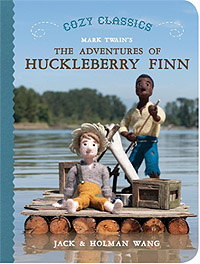 Available from Amazon |
16. Cozy Classics; The Adventures of Huckleberry Finn, by Jack & Holman Wang, Chronicle Books, LLC San Fransico, Ca., 2014. This book has the same format as #15.. Twain is the only author with two books that were used in the Cozy Classics series. It is a "board book" aimed at five to six-year-old readers and part of a series of famous books, including the Wizard of Oz and Star Wars that are used as a base to teach children words and how to read. |
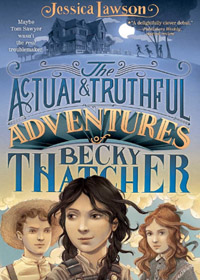 Available from Amazon |
17. The Actual and Truthful Adventures of Becky Thatcher by Jessica Lawson, Simon & Schuster, New York. 2014. According to Jessica Lawson's website, she is an author of books for young readers, including this one. This was her first novel, and she has published four others since. In her acknowledgments on the opening page, she starts by thanking Mark Twain for whom she has the "most respect and admiration for your work." This book is targeted to young readers, particularly young girls. According to the review at Goodreads, Becky is eleven years old in 1860 and the new girl in town. Her brother has recently died, her Mama is frozen in grief, her father, the Judge is busy at work. So, Becky is often on her own, and gets into her own adventures. Tom follows her around, and her best friend Amy (a minor character in Twain's book) joins her in mischief. Sam Clemens makes a cameo appearance in the book on page 18
as a riverboat pilot. |
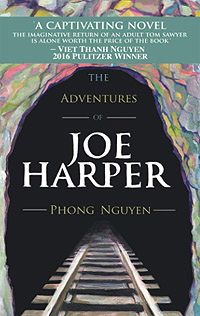 Available from Amazon |
18. The Adventures of Joe Harper by Phong Nguyen, Outpost19, San Fransico, Ca., 2016. According to Phong Nguyen's website, he is a professor of creative writing at the University of Missouri and the author of six books. The year is 1871 and the book starts in Missouri. Joe Harper, a minor character in Twain's The Adventures of Tom Sawyer is the narrator. A review on the Goodreads website states this book is used to "extend Twain's savvy commentary on the struggles of Chinese Americans, women and the outcasts in Reconstruction America." In Twain's book, Tom's gang liked to play pirates, and in this new novel, Joe Harper has grown up to become a real pirate, but a failed one. He is back in St. Petersburg, looking for a cave to live in, starting in Injun Joe's Cave Hollow, but moving on to the Ozarks. Joe meets a Chinese railroad worker, and an Amish woman fleeing a forced marriage. They head West, have their adventures, are forced to work on a chain gang, escape and are chased by enemies. And as in Adventures of Huckleberry Finn, Tom shows up to rescue them in a way only Tom could. |
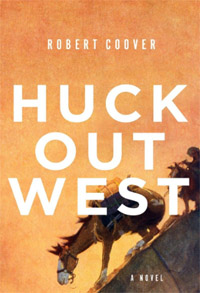 Available from Amazon |
19. Huck Out West by Robert Coover, W. W. Norton & Co, New York, 2017. The Wikipedia entry on Robert Coover, who died in October 2024, described him as a Professor Emeritus in Literary Arts at Brown University where he taught for over thirty years and a postmodernist novelist having published 65 books, numerous short stories and four plays. From Coover's inside cover, this book starts at the end of the Adventures of Huckleberry Finn and about the time of the Civil War and continues over about 25 years. Tom, Huck and Jim leave for Indian Territory. Tom soon decides he misses his old life, returning to marry Becky Thatcher. Huck is on his own, but soon meets a new friend, a Lakota Indian, Eetch. Tim
Champlin's review on the Mark Twain Forum is excellent.
(Champlin has four Tom/Huck books in this list -- #10,
#20, #21, #26). Champlin rightfully described
this book as "a very strange, dark novel." Huck is
the narrator, but as Champlin points out, Coover attempts at
duplicating "Huck's dialect appears to be written for the
eye, not the ear." |
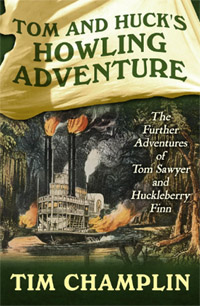 Available via Amazon used book dealers |
20. Tom and Huck's Howling Adventure: The Further Adventures of Tom Sawyer and Huckleberry Finn by Tim Champlin, Wheeler Publishing, a part of Gale, a Cengage Company, Mexico, 2017. This is Champlin's second book on this list, and the first of a three-volume set "Adventures in Time--1849." (#10, #21, #26). All his books are aimed at young readers. Besides Huck and Tom, this series also includes a new main character for all three books, a thirteen-year-old time traveler from the 21st Century, Zane Rasmussen. If the last name looks familiar to Twain scholars, it should. Per Champlin in an interview with Brandy Wyatt of the Dalton (Ga) Daily Citizen in June 2020, "Zane is based on the real-life grandson of my friend, Kent Rasmussen." Zane first appears in Chapter Three. He is starting summer vacation and has just finished reading Twain's original two books. Zane is waking up, after regretting eating a peanut candy bar to which he had an allergic reaction. He soon meets Tom, Huck and Jim. Zane eventually accepts them as real, and they accept that he is from the 21st century. They soon become friends. Their plans to go to Indian territory are interrupted when they must save Becky from kidnappers. At the end, Zane realizes that he does not know the way home, so decides to stay for a while. Goodreads features a brief review of the book. |
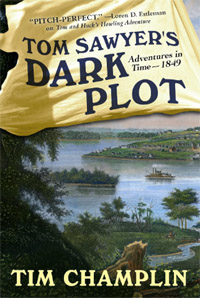 Available via Amazon used book dealers |
21. Tom Sawyer's Dark Plot by Tim Champlin, Wheeler Publishing, a part of Gale, a Cengage Company, Mexico, 2018. This is Champlin's third book on this list, (#10, #20, #26) and second in his "Adventures in Times Series-1849" According to the Goodreads synopsis of the book Tom's game-making attempt at fun adventures backfires. Tom leads Huck, Zane and other Twain characters in tricking the residents of St. Petersburg that Bigfoot type monsters are migrating up the Mississippi. They leave "evidence" of footprints and blood, after" killing" one of the monsters and saving the town. But the heroes have a big problem, when a man is found mauled and large footprints are found. It turns out that Becky's kidnappers from book one of this series (#20) are around. The story builds, setting up the youngsters, the law, and the villagers all coming together to solve the crime. At the end of the book Zane decides he does not want to return to his time in the 21st Century but wishes to stay with his friends. |
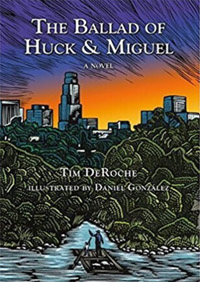 Available from Amazon |
22. The Ballad of Huck & Miguel by Tim DeRoche. Illustrated by Daniel Gonzalez, Redtail Press, Los Angles, Ca., 2018. According to Tim DeRoche's website, this was his first book and he has since written two others. It is also the first book Daniel Gonzalez illustrated. There are many structural parallels between this book and Adventures of Huckleberry Finn. The book's illustrations, while not as numerous, remind one of Edward Kimble's in the first edition of Twain's book, and give a similar feel. The book is told by Huck. The book is set in modern-day Los Angles, rather than the pre-Civil War. The book starts in St. Petersburg, but in the first chapter "Pap and I Light Out for California." Huck meets Tom Sawyer after arriving in California. Pap is soon arrested in a drug deal and Huck goes to live with Miss Watson and Ms. Douglas, who are a lesbian couple. There are many new characters. The Los Angeles River is the new Mississippi River, an illegal immigrate named Miguel replaces the slave Jim, who is not in this book. Pap who used the "N" word often in Twain's book, now uses "Mexigrants" for his prejudiced viewpoints. Pap Finn still tries to get Huck's money, but this time the source of the money was a reward for catching drug thieves. Adventures abound. Kirkus
Reviews called the book "A smart, highly entertaining
update on a classic story." |
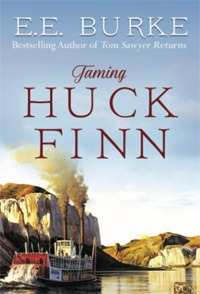 Available from Amazon |
23.Taming Huck Finn by E. E. Burke, self-published, 2018. E. E. Burke has written sixten books, including one that was
in the Kindle top 100. According to
Burke's website, she describes herself as a "history
geek and a sucker for a good love story." This is one of
her two Tom and Huck books (see # 25) in her "New
Adventures" series, and can be classified as an American
historical romance. The Dedication at the front of the book
reads, "The book is dedicated to the extraordinary man
who gave America an unforgettable orphan named Huckleberry Finn." The year is 1870, and Huck is a river pilot on the Missouri (not Mississippi) river. He lives an independent life with no entanglements. That is, until he is named guardian of Tad, an eight-year-old orphan. At first Huck does not want the responsibility, but over time, circumstances and a questionable claim by a spinster cause Huck and Tad to head up the Missouri through various adventures. By the end, all works out with Huck happily married to Haillie who is pregnant, with Tad becoming part of the family, and having a riverboat named Huckleberry Finn. |
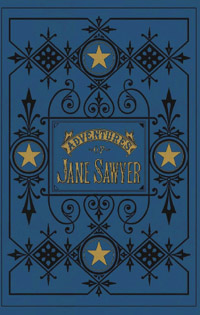 Available from Amazon |
24. The Adventures of Jane Sawyer by Mark Twain and William Bott, Orange Hat Publishing, Waukesha, Wi., 2019. According to William Bott's Goodreads page, he is the author of eight books. The first thing one notices in this edition is
that the cover design looks exactly like the cover design of
the original 1876 edition of The Adventures of Tom Sawyer
issued by the American Publishing company. The next thing one
notices when opening the book is that there are no illustrations
like True Williams's in the original. The words throughout this
book are the same as Twain's original except for one major difference
throughout--names and sexes have been changed. Tom is now Jane,
Jim is Rosie, Becky is Edward, Sid is Sidney etc. Judge Thatcher
is a female. However, Huckleberry remains Huckleberry! The Amazon page for this book asks "Why should boys have all the fun? This is Tom Sawyer for girls…keeping the authenticity of the original." |
 Available from Amazon |
25. Tom Sawyer Returns by E.E. Burke, self-published, 2020. This is E. E. Burke's second Tom and Huck book on this list. As with her first book (#23) , it opens with a Dedication, this time to "the gifted storyteller who brought Tom and Becky to life, and to the dear friends who encouraged me to tell the rest of their story." Another romance story, this one is set during the Civil War. And it is about Tom and Becky. Her father, the Judge, is in jail for treason, and she needs help. The book starts with her thinking of her recent love, Alfred. While there are other characters, including Huck who surface in this book, this is Becky's story and to a lesser extent Tom's. Tom has been away for ten years when Becky runs into her troubles. The author states that "in Twain's book, the character of Becky Thatcher fits the traditional stereotype of the Victorian female; beautiful, helpless, idealized, and quite frankly boring" (p. vii). In this book Becky has "cleverness, compassion, courage and a sense of adventure" along with "spunk" (p. viii). And the book has a happy ending with Tom asking Becky to marry him. According to Burke's web page, this book was featured as a Valentine Day Event by the Mark Twain House in Hartford in 2022. The book also received two awards, including the Laramine 2021 Grand Prize. |
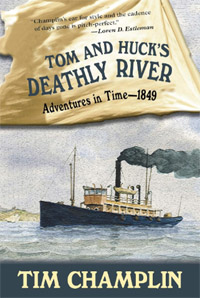 Available via Amazon used book dealers |
26. Tom and Huck's Deathly River by Tim Champlin, Wheeler Publishing, a part of Gale, a Cengage Company, Mexico, 2020. This is Champlin's fourth book on this list, and third in his "Adventures in Times- 1849" series (#10, #20, #21). And it is the last in the series. The book starts with the three main boys (Tom, Huck and Zane) discussing the big hairy Bigfoot monsters from Champlin's last book. While Tom and Huck have just started school, Zane caught in the wrong century has not. Being bored, Tom suggests new adventures that Zane, Huck, along with familiar and new companions agree to. They travel for Halloween back towards the Grangerford log house, site of the famous feud from Twain's original work. And from the Goodreads website, "They try to intercept a steamboat carrying stolen slaves to New Orleans." The book ends with Zane returning back to his time, thanks to a potion given to him by a girl he meets, Mint. He awakens from an "ill-formed" dream on the same day that his time travel had started back on book 1 of the series. But he has to explain to his father why he is "wearing a wig" and "where'd you get those clothes?" (p. 347). |
 Available from Amazon |
27. Jim's Journey Homeward, Book One: Escape with Huckleberry Finn by Mark Time, self-published, 2022. This book was also self-published under the title Black Lives Matter Too, My Adventures with Huckleberry Finn (2018). Mark Time is the pseudonym of an English author of sixteen books. His Goodreads profile describes him as a contributor to national press and satirical websites. He states on the back cover of his books, that he chose a pen name like Mark Twain, and his was an expression commonly used in a job that he used to have before becoming a writer. This is the first of three books by Mark Time using Tom and Huck characters. Following Time's names, titles, and order of books can get confusing. All three make one continuous story, and therefore should be read in order. This book is the first of what he calls his "Bootneck Threesome Trilogy." He also uses the term "Mississippi Trilogy." It is also the first of two of these books using the title "Black Lives Matter." The three books reviewed here total 1,544 pages with no illustrations--more pages than Mark Twain published on Tom/Huck while alive. There are many structure similarities in this first book, Jim's
Journey Home, Book 1 to Adventures of Huckleberry Finn,
but they are used to established differences. Like Twain, Chapter One by Time mentions "You know about me" but rather than referring to Adventures of Tom Sawyer, he is referring to Adventures of Huckleberry Finn, and to Huck Finn's storytelling, not Twain's. Jim is the narrator of this book. A review on Goodreads explains that "Time addresses critical omissions from the original Tom Sawyer and Huck Finn books--Mark Twain ignoring the slave's perspective and the seriousness of slavery." Adventures continue down the river, and end at the same plantation at the end of Adventures of Huckleberry Finn. |
 Available from Amazon |
28. Jim's Journey Homeward, Book Two: Return with Huck and Tom Sawyer by Mark Time, self-published, 2022. Similar to a Notice by G.G. as in Mark Twain's Adventures of Huckleberry Finn, this book has a Notice by "the Author per JPZz. , Chief of Ordnance" (p. 3). And in this book's Explanatory, Time claims the book does make use of several diatribes, with help from the Author's secret helper. However, these are hard to find. This book starts where both the Adventures of Huckleberry Finn, and Time's Book 1 (#27 above) ends, at Aunt Polly's plantation. It is an entirely new story. Rather than heading to Indian territory, Jim, Huck and Tom head first to New Orleans and then back to St. Petersburg. They stop at some of the same locations that they had visited coming down river, but now Jim is a free man. There are many original Tom and Huck characters along with many new ones. Like the previous book in this trilogy (#27), a Goodreads review states that this book addresses "the second critical omission in Mark Twain's two books--ignoring the women's perspective--by re-imagining the character of Aunt Polly and creating a new character to be the girl-equivalent of Tom and Huck, Miss Melissasippi Jane." At the end of the book Jim moves to the free state of Ohio, but without his family who are still slaves. And similar to Huck's sign off at the end of Mark Twain's book "The End, Yours Truly, Huck Finn," this book ends with a comment by Jim--"The End (Of My Second Book), Yours Truly, James Nathaniel Douglas" (p. 497). |
 Available from Amazon |
29. Jim's Journey Homeward, Book Three: Search for Tom Sawyer and a Soldier Son by Mark Time, self-published, 2022 This is the third book of Mark Times' series on Tom/Huck. (See #27 and #28 above.) This story continues where the last one (#28) ended. The Goodreads web site provides a good summary of the book. Jim is living in Ohio trying to get his family. With the help of Tom Sawyer and Aunt Polly he succeeds. After about ten years the Civil War commences. Tom goes to fight for the North, and as was common for officers in this war brought along a black man servant, Johnny. (According to Mark Twain researcher Kevin Mac Donnell in his article "George Griffin; Meeting Mark Twain's Butler Face to Face" in Mark Twain Journal Spring 2024, p. 13-14 this was a common practice in the war.) Johnny is Jim's son. Tom and Johnny go missing in action at the Battle of Shiloh. Jim and his daughter then go in search to find them. |
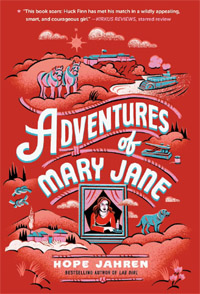 Available from Amazon |
30. Adventures of Mary Jane by Hope Jahren, Delcorte
Press, New York, 2024. She states that thirty years ago, when she was a young student that she had several "comfort books" that she would often read, including Adventures of Huckleberry Finn. She would often ask teachers why female characters did not say or do anything? (p. xi). In Adventures of Mary Jane, she establishes a very strong female lead character. The book is from Random's House Children's division. But it's length of 441 pages, some of the themes and topics, and one of the main new characters are more adult in nature, or in today's environment, at least high school level. Mary Jane appears in Chapters 24 through 29 in Mark Twain's Adventures of Huckleberry Finn as one of the three nieces of Peter Wilks. In these chapters Peter Wilks dies, and the King and Duke impersonate his two brothers from England who try to steal the girl's inheritance. Huck hides the gold in the coffin, keeping it safe from the con men. Jahren states in her Introduction that these chapters never sat right with her, and she wanted to correct the "ineptitude of Mark Twain" (p. xii). In Twain's book, Huck states "she (Mary Jane) had more sand in her than any girl I ever see…..when it comes to beauty--and goodness too--she lays over them all…..I reckon I've thought of her a many and many a times" (Adventures of Huckleberry Finn, Chapter 28). Jahren provides the back story of Mary Jane, her cousins Susan and Joanna, and Peter Wilks. Mary Jane has her own adventures traveling the Mississippi from its start down to Greenville, Mississippi before it picks up Twain's story for just fifty of the book's 441 pages. While this overlapping is faithful to Twain's story, they are from Mary Jane's not Huck's perspective. Huck is not mentioned by name anywhere in the book, although you know it is him. Huck is now a "blue-eye-pony-tail boy," which is not how I ever pictured him. Mary Jane's feeling for Huck is reciprocal. All the four minor characters become more fully developed. Peter Wilks becomes a terrible person including being a sex molester, and we find out how he obtained so much gold. Jahren knows Twain. There are many passages in the book that only a true Twain fan will appreciate. She has many of Twain's original crew, especially from The Adventures of Tom Sawyer at the end of the book. Sam and Olivia Clemens even make a cameo appearance in Chapter Eight when Mary Jane first visits St. Petersburg. However, Clemens comes off as a friendly old man who tells too many stories. At the end of the book Jahren explains her historical sources for some of the characters and scenes in the book, which give it even more credence. But some of the new themes that she introduces, and a major new character, Mrs. Captain, who is not based on historical sources, is where criticism of the book is focused. Meg Cox Gurdon's review in the Wall Street Journal has issues with several of the characters and themes that have been added. Gurdon states that these forms of "representation" that modern authors like to add, is the "problem at the heart of the novel." Mrs. Captain is portrayed as a crossdresser. Gurdon states that this "could have been an exciting story" but is "an excuse for brainwashing." |
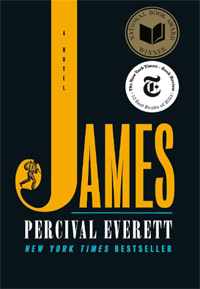 Available from Amazon |
31. James by Percival Everett, Doubleday, division of
Penguin Random House LLC. New York, 2024. From his Wikipedia entry, Percival Everett is Distinguished Professor of English at University of Southern California.. He has written over twenty books, poetry and short stories and has received many writing awards and has been a Pulitzer Prize Finalist. James is by far the greatest of all books by other authors using Twain's Tom and Huck characters. This book has been in the top ten bestselling fiction books in the USA throughout the spring, summer and fall of 2024. Even though it was only available for five months, James made the readers pick for the New York Times top 100 books of the 21st Century, issued in July 2024, coming in at number fifty. And Amazon listed it as the #1 Best Book in the first half of 2024. Although it did not win, Jim was nominated for the prestigious Booker Prize for fiction. Jim has received very favorable reviews including from the Wall Street Journal, American Booksellers Association, Esquire, Chicago Tribune to name a just a few. Everett was also featured in a Mark Twain House interview regarding the book, which can be watched on Youtube. Since so much has been written about this author, and this book, not much more is needed here. Everett gives a fully developed life to Jim. He follows the original story of Adventures of Huckleberry Finn but told from Jim's perspective. As in the original story Huck leaves Jim behind while having some of his adventures, and from page 144 through page 247 we find out what Jim is up to while Huck is away. And we learn more about Huck's relationship with Jim. Everett is very respectful of Twain and his work, and his interpretation will get readers thinking. This book is best read after reading Twain's original Adventures of Huckleberry Finn, which Everett did fifteen times in a row before starting to write James as he revealed in an interview with Zoe Perzo. |
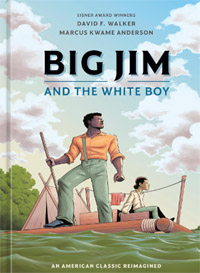 Available from Amazon |
32. Big Jim And The White Boy by David F. Walker and Marcus Kwame Anderson, Ten Speed Graphic, California/New York, 2024. David F. Walker and Marcus Kwame Anderson have coauthored other books, winning an Eisner Award (the Oscars of graphic novels presented annually at Com Con, San Diego). Walker has also written many other comic books, is a film maker and teaches part time at Portland State University. Anderson is an illustrator, artist and teacher. Isabell Struble also assisted in the coloring (p. 281). This is the second graphic novel on this list (see # 8 above). If you have never read a graphic novel before, this is the one to try. The story is communicated via words, pictures, and colors. Some pages have no or very few words but are very "vocal." There are historical notes, and a list of resources that ground this work of fiction in real life. The story begins with a few drawings of Mark Twain, a brief Twain biography, and a few pages in black and white retelling the Walter Scott steamboat scene from Adventures of Huckleberry Finn. From there the story emerges very differently that Twain's. According to this book's back cover, "Critics have rightfully condemned Mark Twain's troubling portrayal of Black Americans as stereotypes and caricatures." In the book Twain is criticized for "sugar coating slavery" (p. 268). In several places the author states that Twain should have told us more about Jim, and Jim's family (p. 66). This criticism ignores the fact that Adventures of Huckleberry Finn is Huck's book, not Jim's. In the Author's Note at the front of the book, there is a discussion of the "n" word. "I do not like the word, but it is important to authenticity of the historical period in question not to avoid it, ugly and offensive as it may be." The word is used throughout this graphic novel, but with a line drawn through it. This 270-page story, is about Jim. It is through oral family history, three generations past Jim, ending with his great granddaughter teaching at Howard University that we learn his history. We hear Jim, at 101 years of age, sitting next to his long-term friend Huck. The bantering between the two is comical and brings much needed laughs to a heart wrenching story. We learn who Huck's mother is, what his relationship to Jim is (unlike several other stories above it is not as his father), and that Joe Finn (Pap) named Huck "the white boy." We see Jim and Huck searching for Jim's family starting in St. Louis, Kansas, and other areas. Jim is caught as a slave, whipped, and Huck and Jim fight in the Civil War. This book was featured at an in-person event at The Mark Twain House on October 24, 2024 |
Conclusion
So, what are we to make of all these authors using Mark Twain's Tom/Huck characters in their own books? If nothing else, it shows how much Twain's work is intertwined into our culture. As our culture evolves and grows so do Tom, Huck and their companions. Some of the stories are just fun. But some of these novels try to address issues in our society. Racism is not just against Blacks but also other groups such as illegal immigrants and Chinese. Some cover themes that Twain never addresses, like rape and prostitution, along with topics like sexual orientation which are brought out into the open. Mark Twain's characters grow and develop, and much like many other children they do not always grow up the way we might desire.
Twain was a prolific writer. In only the first 25 years of the 21st Century 25 authors have published 32 new Tom and Huck books. Twain's characters resonate with readers and have been a good source for new material. Twain himself also used another author's character in one of his stories. In his 1902 satirical mystery tale, A Double Barrelled Detective Story, Twain uses Sir Arthur Conan Doyle's Sherlock Holmes, and makes fun of the detective's crime deducing skills. Not all Sherlock Holmes fans are appreciative.
I have always pictured Tom and Huck as Mark Twain wrote about them, and True Williams and Edward W. Kemble drew them in the original editions. But others see them differently. One envisions Huck-as a "blue-eye-pony-tail boy," while two others see Huck as a mulatto. And others see them as young men and older adults. Some have given them several "unsaintly" traits. Another one envisions them as twin cats. And that is great! Others can picture Tom and Huck in new images, new themes, new adventures. They view them from a 21st Century perspective. And by doing so they help expand my own interpretations. One of the markings of a great book is that it stirs imagination, gets us to think. Twain's works continue to do exactly that. And as they continue to do so going forward, it is likely to lead readers back to Twain's original gems.
Acknowledgments
I would like to thank Joe Fulton for his encouragement in attempting this article, and Kevin Mac Donnell for his assistance. At the start of this project, I had six of the above Tom/Huck books. Kevin provided a list that included most of the others without which this article could not have been written. I have also searched for and stumbled upon a few others. I cannot claim this to be a complete list, so if any are missing, please let me know.
~~~~~
June 2025 Update
|
Not surprisingly, two more books have been found to add to the above original listings. Both are from Manga Classics. Mangas are Japanese style Graphic novels. Manga books are read in reserve--that is you start reading from the back cover to the front, and pages right to left, not left to right. This change in reading patterns can be difficult, and tiring, until one becomes familiar with it.This brings the total number of authors to 26 with 34 books.
This brings the total number of new Tom/Huck books issued in the first 25 years of the 21 st Century to 34! |

